
Standard English Name(s): Pacific
treefrog, Pacific chorus frog
Local English Name(s): "spring peeper"
Scientific Name(s): Pseudacris regilla (Baird and Girard)
(syn. Hyla regilla Baird and Girard)
Upriver Halkomelem Name(s):
Downriver Halkomelem Name(s):
Island Halkomelem Name(s):
Description, Habitat, Ecology, & Distribution:
Generally speaking, treefrogs are typically
small, slim-wasted, and long-legged frogs that jump and can climb vegetation
by virtue of adhesive pads on their toes. Our local treefrog is one
of the tiniest frogs in British Columbia (from 25-50 mm long, with females
being larger than the males) and is further distinguished as the only
local frog to have prominent toe pads. Individual treefrogs are capable
of changing their colour from light green (in warm, dry conditions)
to dark brown (in cold, damp conditions) and all shades in between.
Pacific treefrogs also possess a prominent dark stripe extending on
both sides of the body from the snout back to the shoulder. They inhabit
open woods and forest margins where they may be found clambering about
amidst the stems and foliage of shrubby vegetation. They are distributed
throughout the southern one-third of British Columbia (and the entire
Halkomelem territory) and have been introduced into the Queen Charlotte
Islands. Their diet consists of a wide variety of crawling and flying
insects.
Like its eastern cousin, the spring peeper
(Pseudacris crucifer (Wied-Neuwied), the Pacific treefrog is
known to produce a loud and distinctive mating call during the breeding
season in the spring. For this reason, this species is alternately known
as the Pacific chorus frog and "spring peeper."
Upriver Halkomelem Cultural Role(s):
Downriver Halkomelem Cultural Role(s):
Island Halkomelem Cultural Role(s):